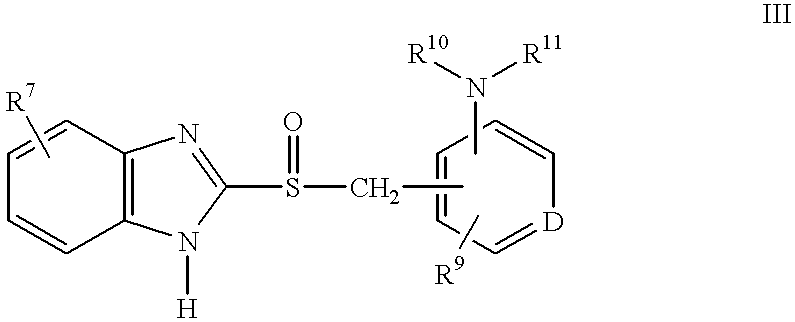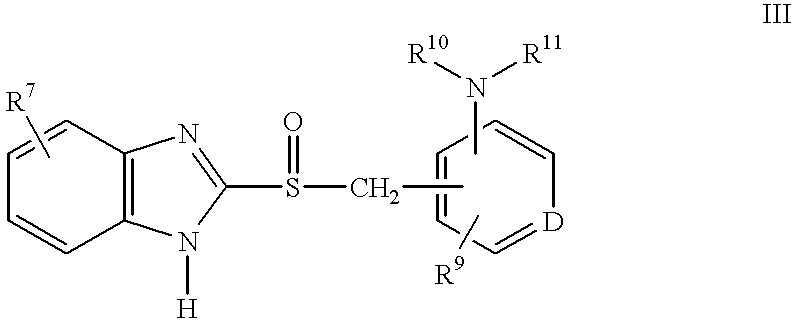Method of using (H+/K+) ATPase inhibitors as antiviral agents
a technology of atpase inhibitors and antiviral agents, which is applied in the field of methods of treating subjects with viral infections, can solve the problems of few viable therapies for the treatment of viruses and substantial side effects of therapies
- Summary
- Abstract
- Description
- Claims
- Application Information
AI Technical Summary
Benefits of technology
Problems solved by technology
Method used
Image
Examples
example 1
2-[(1H-Benzimidazol-2-ylthio)methyl]-N,N-dimethylbenzenamine
[0562]A mixture of 2.20 g (14.6 mmole) of 2-mercaptobenzimidazole and 3.0 g (14.6 mmole) of 2-(chloromethyl)-N,N-dimethylaniline in 120 ml of absolute ethanol were stirred under nitrogen for about two hours. A solid (4.8 g) was collected by filtration, washed with ethanol, and air-dried. The solid was dissolved in water and made basic with potassium carbonate, then extracted into dichloromethane. The organic phase was dried over sodium sulfate, filtered, and concentrated in vacuo to dryness. Recrystallization from acetonitrile gave 2.3 g of a white solid (first crop). Concentration of the acetonitrile liquors gave 0.7 g of a second crop. The two crops were combined and recrystallized from isopropyl alcohol, giving the title compound as an analytically pure solid, m.p. 167-170° C. Analysis. Calc'd. for C16H17N3S: C, 67.81; H, 6.05; N, 14.83; S, 11.31. Found: C, 67.84; H, 6.19; N, 14.73; S, 11.50.
example 2
2-[(1H-Benzimidazol-2-ylthio)methyl]benzenamine
[0563]A mixture of 9.0 g (60 mmole) of 2-mercaptobenzimidazole and 4.9 g (40 mmole) of 2-aminobenzyl alcohol were heated at 84° C. in a mixture of 45 ml of glacial acetic acid and 12.0 g (120 mmole) of sulfuric acid. After two hours an additional 1 g (8 mmole) of 2-aminobenzyl alcohol and 1 g of sulfuric acid were added. After one hour the reaction mixture was cooled and poured into cold benzenamine hemihydrate.
example 3
2-[(1H-Benzimidazol-2-ylsulfinyl)methyl]benzenamine
[0564]The title product of Example 2 (830 mg, 3.25 mmole) was dissolved in about 200 ml of boiling chloroform and then cooled to about −10° C. A solution of 662 mg (ca. 3.25 mmole) of ca. 85% m-chloroperoxybenzoic acid in 10 ml of chloroform was then added with stirring over about ten minutes. After another thirty minutes, the reaction was quenched with 4 drops of dimethylsulfide and a white solid was collected by filtration. The solid was washed sequentially with chloroform and diethyl ether, then air dried, giving 550 mg of the title compound: m.p. 164-165° C. Analysis. Calc'd. for C14H13N3OS*½ H2O: C,59.98; H,5.03; N, 15.00; S, 11.44. Found: C, 60.11; H, 4.82; N, 14.93; S, 11.44.
PUM
| Property | Measurement | Unit |
|---|---|---|
| temperature | aaaaa | aaaaa |
| temperature | aaaaa | aaaaa |
| temperature | aaaaa | aaaaa |
Abstract
Description
Claims
Application Information
 Login to View More
Login to View More - R&D
- Intellectual Property
- Life Sciences
- Materials
- Tech Scout
- Unparalleled Data Quality
- Higher Quality Content
- 60% Fewer Hallucinations
Browse by: Latest US Patents, China's latest patents, Technical Efficacy Thesaurus, Application Domain, Technology Topic, Popular Technical Reports.
© 2025 PatSnap. All rights reserved.Legal|Privacy policy|Modern Slavery Act Transparency Statement|Sitemap|About US| Contact US: help@patsnap.com



